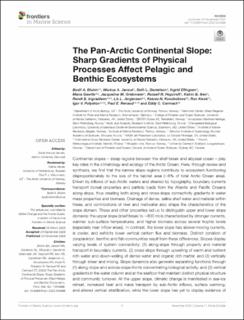| dc.contributor.author | Bluhm, Bodil | |
| dc.contributor.author | Janout, Markus | |
| dc.contributor.author | Danielson, Seth L. | |
| dc.contributor.author | Ellingsen, Ingrid H. | |
| dc.contributor.author | Gavrilo, Maria | |
| dc.contributor.author | Grebmeier, Jaqueline | |
| dc.contributor.author | Hopcroft, Russell R. | |
| dc.contributor.author | Iken, Katrin | |
| dc.contributor.author | Ingvaldsen, Randi Brunvær | |
| dc.contributor.author | Jørgensen, Lis Lindal | |
| dc.contributor.author | Kosobokova, Ksenia N. | |
| dc.contributor.author | Kwok, Ron | |
| dc.contributor.author | Polyakov, Igor V. | |
| dc.contributor.author | Renaud, Paul E. | |
| dc.contributor.author | Carmack, Eddy C. | |
| dc.date.accessioned | 2021-01-15T12:01:48Z | |
| dc.date.available | 2021-01-15T12:01:48Z | |
| dc.date.created | 2021-01-09T23:05:35Z | |
| dc.date.issued | 2020-11 | |
| dc.identifier.issn | 2296-7745 | |
| dc.identifier.uri | https://hdl.handle.net/11250/2723262 | |
| dc.description.abstract | Continental slopes – steep regions between the shelf break and abyssal ocean – play key roles in the climatology and ecology of the Arctic Ocean. Here, through review and synthesis, we find that the narrow slope regions contribute to ecosystem functioning disproportionately to the size of the habitat area (∼6% of total Arctic Ocean area). Driven by inflows of sub-Arctic waters and steered by topography, boundary currents transport boreal properties and particle loads from the Atlantic and Pacific Oceans along-slope, thus creating both along and cross-slope connectivity gradients in water mass properties and biomass. Drainage of dense, saline shelf water and material within these, and contributions of river and meltwater also shape the characteristics of the slope domain. These and other properties led us to distinguish upper and lower slope domains; the upper slope (shelf break to ∼800 m) is characterized by stronger currents, warmer sub-surface temperatures, and higher biomass across several trophic levels (especially near inflow areas). In contrast, the lower slope has slower-moving currents, is cooler, and exhibits lower vertical carbon flux and biomass. Distinct zonation of zooplankton, benthic and fish communities result from these differences. Slopes display varying levels of system connectivity: (1) along-slope through property and material transport in boundary currents, (2) cross-slope through upwelling of warm and nutrient rich water and down-welling of dense water and organic rich matter, and (3) vertically through shear and mixing. Slope dynamics also generate separating functions through (1) along-slope and across-slope fronts concentrating biological activity, and (2) vertical gradients in the water column and at the seafloor that maintain distinct physical structure and community turnover. At the upper slope, climatic change is manifested in sea-ice retreat, increased heat and mass transport by sub-Arctic inflows, surface warming, and altered vertical stratification, while the lower slope has yet to display evidence of change. Model projections suggest that ongoing physical changes will enhance primary production at the upper slope, with suspected enhancing effects for consumers. We recommend Pan-Arctic monitoring efforts of slopes given that many signals of climate change appear there first and are then transmitted along the slope domain. | en_US |
| dc.language.iso | eng | en_US |
| dc.rights | Navngivelse 4.0 Internasjonal | * |
| dc.rights.uri | http://creativecommons.org/licenses/by/4.0/deed.no | * |
| dc.subject | biological communities | en_US |
| dc.subject | boundary current | en_US |
| dc.subject | climate change | en_US |
| dc.subject | connectivity | en_US |
| dc.subject | continental slopes | en_US |
| dc.subject | panArctic | en_US |
| dc.subject | shelf-basin exchange | en_US |
| dc.subject | vertical and cross-slope gradients | en_US |
| dc.title | Arctic continental slopes sharp gradients of physical processes affect pelagic and benthic ecosystems. | en_US |
| dc.type | Journal article | en_US |
| dc.type | Peer reviewed | en_US |
| dc.description.version | publishedVersion | en_US |
| dc.rights.holder | Copyright © 2020 Bluhm, Janout, Danielson, Ellingsen, Gavrilo, Grebmeier, Hopcroft, Iken, Ingvaldsen, Jørgensen, Kosobokova, Kwok, Polyakov, Renaud and Carmack. This is an open-access article distributed under the terms of the Creative
Commons Attribution License (CC BY). The use, distribution or reproduction in other forums is permitted, provided the original author(s) and the copyright owner(s) are credited and that the original publication in this journal is cited, in accordance
with accepted academic practice. No use, distribution or reproduction is permitted which does not comply with these terms. | en_US |
| dc.source.volume | 7 | en_US |
| dc.source.journal | Frontiers in Marine Science | en_US |
| dc.source.issue | 544386 | en_US |
| dc.identifier.doi | 10.3389/fmars.2020.544386 | |
| dc.identifier.cristin | 1868280 | |
| dc.relation.project | Tromsø forskningsstiftelse: Arctic SIZE | en_US |
| cristin.ispublished | true | |
| cristin.fulltext | original | |
| cristin.qualitycode | 1 | |

